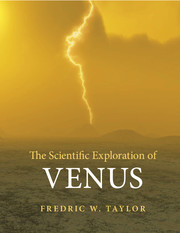Book contents
- Frontmatter
- Contents
- Overview
- Prologue
- A note on scientific units
- Acknowledgements
- Part I Views of Venus, from the beginning to the present day
- Part II The motivation to continue the quest
- Part III Plans and visions for the future
- Epilogue
- References and acknowledgements
- Appendix A Chronology of space missions to Venus
- Appendix B Data about Venus
- Index
- Plate section
Part I - Views of Venus, from the beginning to the present day
Published online by Cambridge University Press: 05 September 2014
- Frontmatter
- Contents
- Overview
- Prologue
- A note on scientific units
- Acknowledgements
- Part I Views of Venus, from the beginning to the present day
- Part II The motivation to continue the quest
- Part III Plans and visions for the future
- Epilogue
- References and acknowledgements
- Appendix A Chronology of space missions to Venus
- Appendix B Data about Venus
- Index
- Plate section
Summary
Views of Venus, from the beginning to the present day
Observations of Venus with the naked eye as a prominent planet or ‘wandering star’ were recorded by the Babylonians around 3000 bc, and have continued ever since. All the major civilisations have contributed knowledge and myth to a recondite and, until recently, quite abstruse concept of our nearest companion in space beyond the Moon. With the invention of the telescope in about 1610 it became clear to Galileo that Venus shone in reflected light from the Sun and had phases like the Moon, leading eventually to an understanding that Venus is not any kind of star, but an Earthlike object, one that orbits closer to the Sun than we do. The presence of an atmosphere on Venus, filled with cloud that veiled the entire planet at all times and prevented the observation of surface features, was recognised and refined from the 1760s onwards, and the principal composition of the atmosphere was established in the 1930s.
- Type
- Chapter
- Information
- The Scientific Exploration of Venus , pp. 1 - 2Publisher: Cambridge University PressPrint publication year: 2014



